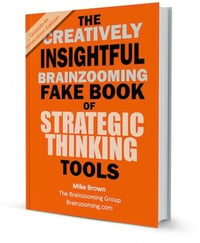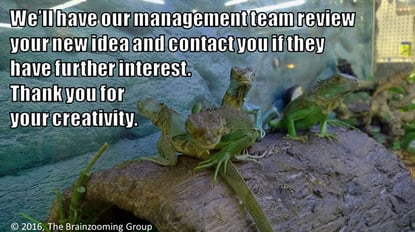Recently, the "Inside the Executive Suite" executive newsletter from Armada Executive Intelligence turned its attention to strategic thinking exercises and possibilities for breakthrough thinking. Their story was based on a review of two new books on the topic of insights. The books and the article were intriguing, and the folks at Armada Executive Intelligence gave us permission to re-run the piece here.
Strategic Thinking Exercises - 5 Breakthrough Thinking Possibilities
(via Armada Executive Intelligence)
How do you personally generate successful breakthrough thinking?
Do your methods compare favorably to approaches of the great thinkers of history? Additionally, are there proven lessons you can apply in specific types of situations?
The last two questions are addressed in new books featured in last weekend's Wall Street Journal Review section. William B. Irvine's, "Aha! The Moments of Insight that Shape Our World," and "The Eureka Factor" by cognitive neuroscientists, John Kounios and Mark Beeman, both address insights – the result of people achieving deep, accurate understanding of an issue facing them.
Irvine's book presents case studies on the thinking approaches of history’s greatest thinkers. The Kounios and Beeman book examines, as much as is possible, the scientific basis for developing insights.
Irvine's book highlights varied, successful insight patterns. In science and mathematics, doing something unrelated to the current task is common before generating breakthrough thinking. He credits religious insights as emerging from actual experience; with moral issues, insights vary in appearing after extended reflection or through sudden revelation. When new thinking depends on creative thinking, they tend to emerge after establishing a solid foundation of work leading to insights that emerge later.
What Works to Generate Breakthrough Thinking?
Figuring out how your situation ties to which type of insight pattern may seem confusing. That’s why we advocate for what Nobel Prize winner Linus Pauling said: "The best way to have a good idea is to have lots of ideas."
You can extend this concept to developing insights. It’s helpful to employ a full repertoire of thinking techniques to produce many potential insights to fuel breakthrough thinking.
We've seen, tried, and returned to various approaches to trigger breakthrough insights. Here are several possibilities when you have to consistently introduce new insights in an organizational setting.
1. Sorting Out What You Know
From all the available potential facts and conclusions, sort them based on ones you KNOW to be true versus others you THINK to be true or HOPE to be true. This exercise helps identify how strong your foundation is for generating new insights.
Are most of your points of information and conclusions already proven to be true? Do you need to develop proof points (if you only THINK much of the information is true) or conduct additional, novel research or analysis (if you simply HOPE the ideas are true)?
Based on what you find, there are natural questions to firm up your fact base:
- For information and conclusions known to be true: What new insights are suggested by what we already know?
- For what you only think to be true, ask: What will it take to prove each of these as true or false?
- For those you hope to be true ask: What stands in the way of vetting this information? If it were true, what new insights might it help uncover?
You can use your answers to take the appropriate steps to solidify your fact base so it is more robust.
2. Assembling the Insight Puzzle
Generating insights in a business setting is akin to assembling puzzle pieces. Extending that comparison creates an actual puzzle-solving exercise.
We worked with a consultant who would print every major known fact supporting a potential strategy and on a separate piece of paper. Each business strategist received a set of facts to combine, rearrange, and "play" with as a child would play with building blocks. Some arrangements of the facts might be simple and others more complex. The overall goal was for each individual to separately identify interesting combinations to look for new potential insights.
While there are advantages to printing out and physically arranging the facts, there are many options to work with the facts in a collaborative online environment.
Regardless of how you do it, after the initial work, strategists compare their insights, looking for similarities, differences, and new ways the individual work can generate additional insights.
3. Different Perspectives on the Insights Puzzle
We also find value in consciously looking at facts from different perspectives to trigger new insights. You can accomplish this with creative thinking exercises.
For generating insights, one approach to looking at your information from alternative perspectives is by consciously using various “modifiers” to probe your fact base in multiple ways. This list of modifiers below is one we typically use. Simply insert the modifier into this question: What if we looked at this information (or situation) in a more ______ way?
- Focused
- Simplified
- Integrated
- Broad
- Diversified
- Sophisticated
- Extreme
- Contrary
- Long-term
- Immediate
Using these types of modifiers will point you in multiple productive directions as you attempt to develop new insights.
4. Invite More People to Look at the Puzzle
Each step to this point involved you or your immediate team. You can expand potential insights by inviting a broader, more diverse group to consider the available information. Including new minds creates an opportunity to identify additional insights, especially ones a group more familiar with a status quo understanding of the situation might struggle to imagine.
5. Get Away Briefly...or Longer
If your insight-generating efforts are unproductive, step away for a short period of time. You may even find it beneficial to stay away longer.
Taking a break agrees with the idea that your previous efforts to generate insights may simply have been foundation-setting that needs time for less structured and casual thinking. A pause can be beneficial in fully exploiting your foundation as a platform for new insights.
Is there a road to breakthrough thinking that works best for you?
The key to generating breakthrough thinking in our experience is that they sometimes come through using tested methods and sometimes through completely new approaches. That requires flexibility on your part. - Armada Executive Intelligence
If you enjoyed this article, subscribe to the free Brainzooming blog email updates.
Looking for Ways to Develop a Successful
Innovation Strategy to Grow Your Business?
Brainzooming Has an Answer!
 Business growth can depend on introducing new products and services that resonate more strongly with customers and deliver outstanding value.
Business growth can depend on introducing new products and services that resonate more strongly with customers and deliver outstanding value.
Are you prepared to take better advantage of your brand’s customer and market insights to generate innovative product ideas? The right combination of outside perspectives and productive strategic thinking exercises enables your brand to ideate, prioritize, and propel innovative growth.
Download this free, concise ebook to:
- Identify your organization’s innovation profile
- Rapidly deploy effective strategic thinking exercises to spur innovation
- Incorporate market-based perspectives into your innovation strategy in successful ways
Download this FREE ebook to turn ideas into actionable innovation strategies to drive your organization’s comeback!
[sc:Outside-In ]





